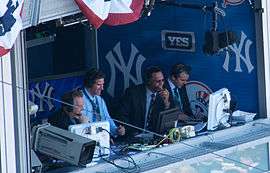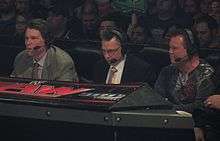Sports commentator
.jpg)
In sports broadcasting, a sports commentator (also known as sports announcer, sportscaster or play-by-play announcer; often called shoutcaster in eSports specifically) gives a running commentary of a game or event in real time, usually during a live broadcast, traditionally delivered in the historical present tense. The comments are normally a voiceover, with the sounds of the action and spectators also heard in the background. In the case of television commentary, the commentators are on screen rarely if at all during the event (although they may appear on camera at the start or near the end of the broadcast).
Types of commentators
Main/Play-by-play commentator
The main commentator, also called the play-by-play announcer or commentator in North America, or lap-by-lap commentator in the case of motorsports coverage, is the primary speaker on the broadcast. They are valued for their articulateness and for their ability to describe each play or event of an often fast-moving sporting event. Because of their skills, some commentators like Al Michaels in the U.S., David Coleman in the UK and Bruce McAvaney in Australia may have careers in which they call several different sports at one time or another. Other main commentators may, however, only call one sport.
Analyst/Color commentator
The analyst or color commentator provides expert analysis and background information, such as statistics, strategy on the teams and athletes, and occasionally anecdotes or light humor. They are usually former athletes or coaches in their respective sports, although there are some exceptions.
The term "color" refers to levity and insight provided by analyst. The most common format for a sports broadcast is to have an analyst/color commentator work alongside the main/play-by-play announcer.[1][2][3] An example is NBC Sunday Night Football in the United States, which is called by color commentator Cris Collinsworth, a former American football receiver, and play-by-play commentator Al Michaels, a professional announcer. In the United Kingdom, however, there is a much less distinct division between play-by-play and color commentary, although two-man commentary teams usually feature an enthusiast with formal journalistic training but little or no competitive experience leading the commentary, and an expert former (or current) competitor following up with analysis or summary. There are however exceptions to this — most of the United Kingdom's leading cricket and snooker commentators are former professionals in their sports, while the former Formula One racing commentator Murray Walker had no formal journalistic training and only limited racing experience of his own.
Although the combination of a play-by-play announcer and a color commentator is standard as of 2014, in the past it was much more common for a broadcast to have no analysts and just have a single play-by-play announcer to work alone. Vin Scully, longtime announcer for the Brooklyn/Los Angeles Dodgers baseball team, is one of few examples of this practice still existing today.
Sideline reporter
A sideline reporter assists a sports broadcasting crew with sideline coverage of the playing field or court. The sideline reporter typically makes live updates on injuries and breaking news or conducts player interviews while players are on the field or court because the play-by-play broadcaster and color commentator must remain in their broadcast booth. Sideline reporters are often granted inside information about an important update, such as injury, because they have the credentials necessary to do so. In cases of big events, teams consisting of many sideline reporters are placed strategically so that the main commentator has many sources to turn to (for example some sideline reporters could be stationed in the dressing room area while others could be between the respective team benches).
Sports presenter/studio host
In British sports broadcasting, the presenter of a sports broadcast is usually distinct from the commentator, and often based in a remote broadcast television studio away from the sports venue. In North America, the on-air personality based in the studio is called the studio host. During their shows, the presenter/studio host may be joined by additional analysts or pundits, especially when showing highlights of various other matches.
Sportscaster
In North American English, sportscaster is a general term for any type of commentator in a sports broadcast. It may also refer to a sports talk show host or a newscaster covering sports news.
United States

While sports broadcasts took place from 1912, Florent Gibson of the Pittsburgh Star newspaper broadcast the first sports commentary in April 1921, covering the fight between Johnny Ray and Johnny "Hutch" Dundee at the Motor Square Garden, Pittsburgh.[4]
In the United States, nearly all professional sports teams, most collegiate teams — as well as a dwindling number of high schools — have their own sports commentators, who are usually recognized as the voice of the team on radio broadcasts and are often identified as part of the team like the players and the coaches. In addition, television networks and cable channels will have their own stable of play-by-play announcers who work with various teams - like New York's Number Two Sports Radio Host Michael Kay from YES's New York Yankees baseball network or Mike Breen for New York Knicks basketball on MSG.
Controversies
In 1975, the National Hockey League made headlines when two coaches from the N.H.L. All-Star Game in Montreal allowed Robin Herman and Marcel St. Cyr. access into the men’s locker room. Both were believed to have been the first women ever allowed to enter a professional men’s locker room to conduct a post-game interview.[5] Sport organizations began to follow in the N.H.L.’s footsteps and allowed for other female sportswriters to be given the same access as men sportswriters.[6]
It wasn’t until the year 1977 when Melissa Ludtke, a sportswriter from Sports Illustrated, was given the assignment to cover the Yankees playoff series but was denied entry into the men’s locker room. Baseball commissioner Bowie Kuhn and other officials chose to discriminate her based on her sex. Knowing that this would put Sports Illustrated in a disadvantage from other publishers, Time Inc. and Ludtke filed a lawsuit against Kuhn.[7]
The lawsuit was taken to the U.S. District Court in 1978 where Judge Constance Baker Motley ruled the act as violating the 14th amendment of the U.S. Constitution. The court ruled that the Yankees organization devise a plan to protect the players of their privacy while female sportswriters conducted interviews, suggesting the use of towels.[8]
Society viewed the issue as women sportswriters only wanting access to the men’s locker room to see players naked. After the access of allowing women in was put into effect, the Yankees organization allowed reporters to spend 10 minutes interviewing players and was then asked to leave and wait. Male reporters were unhappy with this and blamed the women from keeping them out and not being able to do their job. For some men they finally understood what women reporters had been dealing with.[9]
In 1990, the issue made its way back into the headlines when Lisa Olson made a public statement revealing that players from the New England Patriots had exposed themselves while interviews were being conducted. This prompted other female reporters who had been harassed to come forward. Accusations were made that women appeared as being “too friendly” while performing interviews or conversing too long with players as though they were flirting. Their credibility became undermined. Thus, the issue of sexism was still present, despite the equal access to men’s locker rooms.[10]
In professional wrestling

Though not always the case, in professional wrestling, the color commentator is usually a "heel sympathizer" (or a supporter of the "bad guys") as opposed to the play-by-play announcer, who is more or less the "voice of the fans" as well as supporters of the "good guys" (or babyfaces). Though both are supposed to show neutral stance while announcing, the color commentators (especially when they support heels) are usually more blatant about their stance than the play-by-play announcers. Jesse "The Body" Ventura and Bobby "The Brain" Heenan pioneered the "heel sympathizer" for color commentary in wrestling. Jerry "The King" Lawler later made a successful transition into the role, though Lawler has since shown more sympathy for faces (partially due to being over with fans after nearly forty years in wrestling). In some cases, commentators are also active managers for wrestlers, usually following continuity as heels. Former Extreme Championship Wrestling color commentator Cyrus was known for having dual roles as a heel manager and a somewhat neutral commentator. It has also been used to keep injured wrestlers in the public eye while they recuperate. Special guest color commentators serve a twofold purpose, the primary is usually to place them in position to interfere with the match they are calling, but also serves to tell the promotors if this performer can "talk" on his own in the ad lib driven commentary role.
See also
| Wikimedia Commons has media related to sports commentators. |
- Announcerless Game, December 1980 NFL game purposely broadcast without TV commentators as an experiment.
- List of sports announcers
- List of Major League Baseball retired numbers#Broadcasters
References
- ↑ http://inklingmedia.net/2012/05/02/color-commentary-and-play-by-play-a-well-rounded-approach-to-facebook/#.Uk8WfhzN63Y
- ↑ http://everydaylife.globalpost.com/color-commentator-12656.html
- ↑ http://www.sportsideo.com/blog/johnlund1120/the-business-ofsports/baseball_basketball_football/the-top-three-keys-for-becoming-a-color-commentator-1681.html
- ↑ Patterson, Ted (2002). The Golden Voices of Baseball. Sports Publishing LLC. p. 12. ISBN 1-58261-498-9.
- ↑ "The first woman through the locker room door, 35 years ago".
- ↑ "This is why female sportswriters can go in men's locker rooms".
- ↑ "This is why female sportswriters can go in men's locker rooms".
- ↑ "Suit won entry to locker room".
- ↑ "Suit won entry to locker room".
- ↑ "This is why female sportswriters can go in men's locker rooms".
External links
| Look up sportscaster in Wiktionary, the free dictionary. |
- Sportcaster Chronicles – Internet radio show in which John Lewis interviews leading American sports announcers.